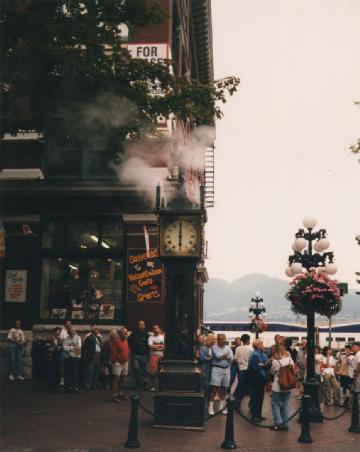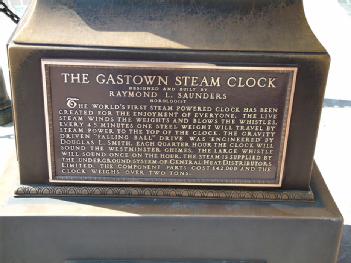
Steam Clock |
V6B 1B8 Vancouver - Gastown, Canada (British Columbia) |
|
| Address |
305 Water Street
|
| Floor area | only roughly guessed: 4 m² / 43 ft² |
Museum typ
Clocks and Watches
|
Opening times
|
24 h every day | ||||
|
Status from 03/2014
|
Free entry. | ||||
| Contact |
|
||||
| Homepage | www.gastown.org/live-work/item/8421-how-to-spend-a-family-day-in-gastown | ||||
Our page for Steam Clock in Vancouver - Gastown, Canada, is not yet administrated by a Radiomuseum.org member. Please write to us about your experience with this museum, for corrections of our data or sending photos by using the Contact Form to the Museum Finder.
| Location / Directions |
Close to everything, Gastown is surrounded by popular hotels, Canada Place, Port of Vancouver and the Trade & Convention Centre. On the Southside you will find GM Place and BC Place. Public Transportation: Skytrain, Vancouver's rapid transit system, Seabus (ferry service from the North Shore), the Canada Line, West Coast Express and city buses from all areas of Vancouver and the lower mainland bring you to Gastown. For more information visit www.translink.bc.ca. Cruise Ship Terminal & Trade & Conventions Centre: Located two blocks West of Gastown, it is an easy five minute walk from the Cruise Ship Terminal or the Trade & Convention Centre. Automobile: Gastown has over 1000 covered parking spaces. |
| Description | From Wikipedia, the free encyclopedia A steam clock is a clock which is fully or partially powered by a steam engine. Only a few functioning steam clocks exist, most designed and built by Canadian horologist Raymond Saunders for display in urban public spaces Raymond Saunders' first steam clock was built in 1977 to solve the issue of a steam vent in a popular sidewalk for the renovated Gastown district of Vancouver, How it worksEngine. The steam engine is a Stuart #4 single expansion double acting 1" piston engine purchased at the Stuart Turner Limited plant at Henley-on-Thames, England. (Engines of this size are typically employed by hobbyists for large model boat propulsion.) It is supplied with low pressure steam — engine inlet pressure is 17 psi (120 kPa) — from a centralized steam heating system that serves a portion of downtown Vancouver. The engine, rotating at only a few hundred revolutions per minute, drives a reduction gear train. The gear train drives an ascending chain lift to lift ball weights to a top track from which they load onto a drive chain providing the driving force to the clock while the ball weights descend.* Chain lift. The engine-driven gear train drives the lower sprocket of a vertical link-chain (similar to a bicycle chain), with a lift of about four feet. Chain-mounted pairs of lifting fingers form forks which accept and lift smooth steel balls (about two inches in diameter). The balls are lifted at a rate of one every 4.5 minutes. * Top transfer. A hammer-like mechanism operates to drive the topmost ball from the lifting fork at the top of the lift. The ball is then received by a transfer chute, whence it is routed to a gate at the top of the drive chain. The ball is restrained until a descending clock drive chain fork is properly positioned to receive it. * Clock drive chain. A similar continuous chain receives the lifted balls from the transfer chute at the top of the mechanism. At any time, five or six balls are being carried by this chain. It is the unbalanced weight upon this chain that drives a conventional pendulum clock mechanism through the upper sprocket. * Ball return. At the bottom of the clock drive chain the balls come to rest upon an inclined blade leading to a chute where they roll to the initial lifting point. Two or three of the balls are in this position, with the foremost awaiting the passage of the lifting fingers. * Clock movement. The Gastown clock keeps time by a small tower clock movement that was custom-built in Croydon, England by Gillette & Johnston Co, from one of their 1875 designs. This type of tower clock movement was used in many small church tower clocks after 1875. * Electric motors. The clock uses three electric motors. First, a small gear motor drives the tune playing machine. It rotates a drum with pins that play the Westminster chimes on micro switches which operate the steam whistle solenoid valves. Second, a small fan motor blows out hot air from the roof vent on top of the clock. Third, a small fan motor pulls warm air down to the base to provide air circulation. v * Chiming mechanism. Five steam whistles are mounted atop the clock case. The large central whistle, off the CPR steam tug Naramata, counts off the full hours. The four auxiliary whistles chime the Westminster Quarters four times an hour. |
Radiomuseum.org presents here one of the many museum pages. We try to bring data for your direct information about all that is relevant. In the list (link above right) you find the complete listing of museums related to "Radio & Co." we have information of. Please help us to be complete and up to date by using the contact form above.
[dsp_museum_detail.cfm]
| Data Compliance | More Information |

 gastown.org
gastown.org 

